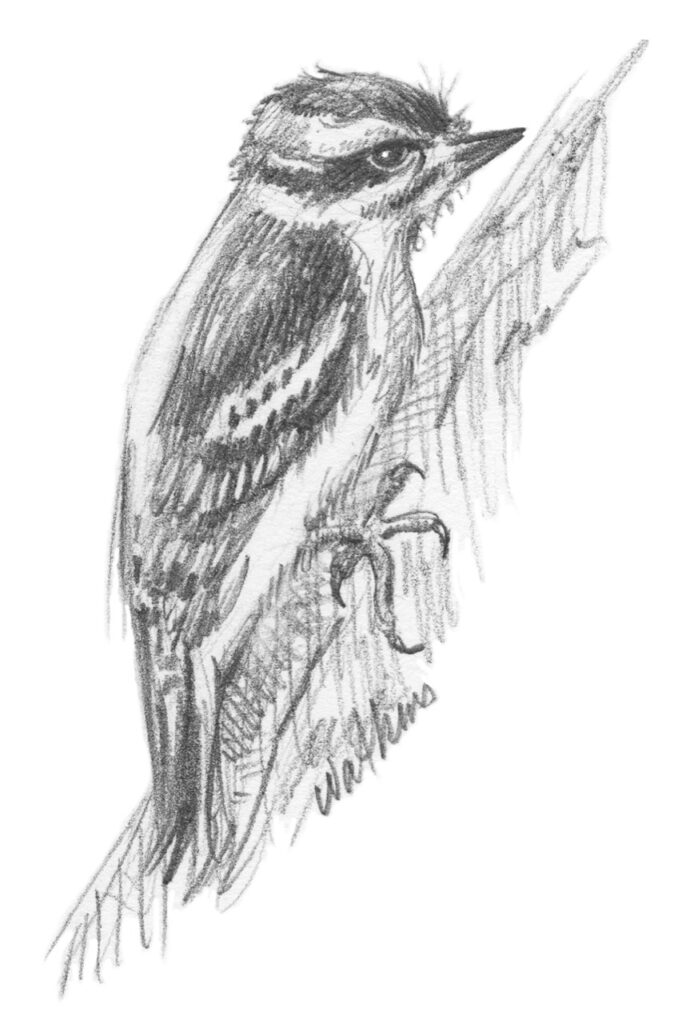March, New England Woodpeckers
Through the Garden Gate

Text and Illustration by Leslie Watkins
The National Geographic Society describes a keystone species as, “an organism that helps define an entire ecosystem. Without its keystone species, the ecosystem would be dramatically different or cease to exist altogether…This means that if the species were to disappear from the ecosystem, no other species would be able to fill its ecological niche.”
Woodpeckers are considered a keystone species for their role in the health of our forests. They are primary cavity excavators. The holes drilled by the woodpeckers as they search for larva in and beneath the bark provide homes for bark nesters and secondary cavity nesters. Animals who live in tree cavities created by woodpeckers include owls, nuthatches, wood ducks, squirrels, bats, raccoons and insects. Over time the holes are gradually enlarged by weather and the various secondary inhabitants as they and their families also increase in size. Most woodpecker species require standing old, dead trees for both foraging and excavating cavities, except for the Hairy Woodpecker, which prefers live trees.
Woodpeckers are also vectors of certain tree fungi. When the birds excavate nest sites in soft, rotted wood they can pass the spores along as they go from tree to tree. Woodpeckers play a very important role in insect control and in the case of spruce bark beetles, studies have shown they brought infestation down as low as 98%. They also protect against the Emerald Ash Borer and other bark borers. To protect old growth forests from pests, specific trees favored by woodpecker species should be preserved in sufficient quantity.
Each type of woodpecker has its own particular drumming rhythm. The bird’s brains are protected from concussion by their remarkably long tongues that provide cushioning by wrapping around their skulls.
Feeder food for woodpeckers includes suet, offered in a suet cage, and other seeds and peanut hearts on a platform feeder. Peanut butter may be spread on pine cones or suet logs and hung near the feeder.
Downy Woodpecker, 5.8-6.5″
The smallest woodpecker in North America and the most common. They’re found in suburban and country settings. Short beaks. The outer feathers on the tail are black. Males have red patch on back of head. Diet: they prefer suet, but will also eat black oil sunflower seeds, hulled sunflower seeds, peanut hearts and chunky peanut butter.
Hairy Woodpecker, 9-9.5″
Looks very similar to the Downy, but is larger with a longer beak proportionately. Its outer tail feathers are white. Males have red patch on back of head. Diet: wood-boring beetles and their larvae, caterpillars, ants and some other insects; nuts, seeds, tree sap, wild fruits and berries.
Northern Flicker, 12-14″
This woodpecker is credited with providing the most secondary cavity nesting sites of the NW American species. Spotted chest, with dashes on back. Males have red patch on back of head, females less so. Bright yellow wing feathers show when it flies. Diet: ants, grasshoppers, beetles, caterpillars, crickets and other insects. Also wild fruits and berries, including wild cherries, dogwood berries, sumac fruit, poison-ivy berries, some seeds and nuts.
Pileated Woodpecker, 16-19″
The largest North American woodpecker, is crow sized. Both males and females have a bright red crest, but the males have red streaks on cheeks. Black body with white patches on wings. Nesting cavities are found in large trees, 50 feet from the ground. Distinctive loud, strong drumming. They leave large rectangular holes while searching for carpenter ants and beetles, other insects. Diet: wild fruits, berries and nuts.
Red-bellied Woodpecker, 9-10″
Bright strawberry-red head and nape, black and white barred back. Belly is beige, but can appear more tan or reddish at times near legs. Diet: insects such as ants, grasshoppers, beetles, acorns, beechnuts, corn, seeds, tree sap, wild fruits and berries.
Red-headed Woodpecker, 7.5-9.5″
Its head is completely red, large black back and white patches on wings, with reverse pattern on underside of wings. White belly. They cache food in tree crevices and holes. Diet: insects and their larvae, spiders, acorns, beechnuts, corn, tree sap, wild and cultivated fruits, berries, sometimes the eggs and nestlings of small birds.
Yellow-bellied Sap Sucker, 8-9″
Males have thick black and white stripes on sides of head. Black and white checkered and speckled pattern on back, red at front of head, yellowish tones on chest and belly. Females have more muted brownish tones on head and chest. They leave rows of holes in tree trunks, sometimes going completely around the tree to release the sap. The oozing sap is also essential to bees, butterflies, porcupines, chipmunks, hummingbirds, bats, hares and squirrels. Tree sap and the inner bark of trees; insects such as ants, beetles, moths, wild fruits and berries.
Also at the Winter Feeder
- Blue Jay
- Chickadee
- Cardinal
- Dark-eyed Junco
- Mourning Dove
- Nuthatch
- Starling
- Tufted Titmouse
- White Throated Sparrows
- Winter Wren
